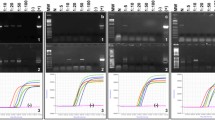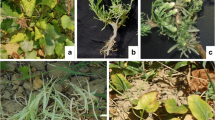Abstract
EcoRI restriction fragments of genomic DNA from the phytoplasma associated with peanut witches'-broom (PNWB) were cloned in plasmid pGEM-3Zf(+). Cloned inserts from seven PNWB-phytoplasma-specific recombinant plasmids and two subcloned plasmids were excised with restriction enzymes, labeled with digoxigenin, and used as probes. Probe PNWB281 and its derivative subclones PNWB281-4 and PNWB281-5 hybridized with DNA from PNWB-phytoplasma infected peanut and periwinkle specifically but not with DNA from healthy plants or plants infected with phytoplasmas associated with sweetpotato witches'-broom (SPWB), loofah, Ipomoea obscura, and paulownia witches'-broom, elm and aster yellows, rice yellow dwarf, and bamboo little leaf disease. Six other probes hybridized with DNA derived from PNWB and SPWB-phytoplasma-affected periwinkle but not with DNA from healthy plants or plants infected with other phytoplasmas mentioned. In Southern hybridizations, four of the nine cloned and subcloned probes could differentiate the PNWB-phytoplasma from SPWB-phytoplasma. Three primer pairs for PCR were synthesized according to the partial sequences at both ends of the cloned inserts and were able to distinguish PNWB-phytoplasma from SPWB-phytoplasma by using PCR for the first time. A minimum of 1 pg and 10 pg of total DNA from diseased periwinkle and peanut, respectively, was sufficient to amplify the specific PNWB-phytoplasma PCR fragments, allowing the detection of PNWB-phytoplasma DNA from healthy-looking periwinkle plants two weeks after graft inoculation.
Similar content being viewed by others
References
Ahrens U and Seemüller E (1992) Detection of DNA of plant pathogenic mycoplasmalike organisms by a polymerase chain reaction that amplifies a sequence of the 16S rRNA gene. Phytopathology 82: 828-832
Bonnet F, Saillard C, Kollar A, Seemüller E and Bove JM (1990) Detection and differentiation of the mycoplasmalike organism associated with apple proliferation disease using cloned DNA probes. Mol Plant-Microbe Interact 3: 438-443
Chang FL, Chen CC and Lin CP (1995) Monoclonal antibody for the detection and identification of a phytoplasma associated with rice yellow dwarf. European Journal of Plant Pathology 101: 511-518
Davis RE and Lee I-M (1993) Cluster-specific polymerase chain reaction amplification of 16S rDNA sequences for detection and identification of mycoplasmalike organisms. Phytopathology 83: 1008-1011
Davis MJ, Tsai JH, Cox RL, McDaniel LL and Harrison NA (1988) Cloning of chromosomal and extrachromosomal DNA of the mycoplasmalike organism that causes maize bushy stunt disease. Mol Plant-Microbe Interact 1: 295-302
Deng S and Hiruki C (1990) Enhanced detection of a plant pathogenic mycoplasma-like organism by polymerase chain reaction. Proc Jpn Acad 66(B): 140-144
Deng S and Hiruki C (1991) Genetic relatedness between two non-culturable mycoplasmalike organisms revealed by nucleic acid hybridization and polymerase chain reaction. Phytopathology 81: 1475-1479
Firrao G, Gobbi E and Locci R (1993) Use of polymerase chain reaction to produce oligonucleotide probes for mycoplasmalike organisms. Phytopathology 83: 602-607
Gundersen DE, Lee I-M, Rehner SA, Davis RE and Kingsbury DT (1994) Phylogeny of mycoplasmalike organisms (phytoplasmas): a basis for their classification. J Bacteriol 176: 5244-5254
Gundersen DE, Lee I-M, Schaff DA, Harrison NA, Chang CJ, Davis RE and Kingsbury DT (1996) Genomic diversity and differentiation among phytoplasma strains in 16S rRNA group I (aster yellows and related phytoplasmas) and III (X-disease and related phytoplasmas). Int J Syst Bacteriol 46: 64-75
Harrison NA, Tsai JH, Bourne CM and Richardson PA (1991) Molecular cloning and detection of chromosomal and extrachromosomal DNA of mycoplasmalike organisms associated with witches'-broom disease of pigeon pea in Florida. Mol Plant-Microbe Interact 4: 300-307
Hobbs HA, Reddy DVR and Reddy AS (1987) Detection of a mycoplasma-like organism in peanut plants with witches' broom using indirect enzyme-linked immunosorbent assay (ELISA). Plant Pathology 36: 164-167
Jiang YP and Chen TA (1987) Purification of mycoplasma-like organism from lettuce with aster yellows disease. Phytopathology 77: 949-953
Kirkpatrick BC, Stenger DC, Morris TJ and Purcell AH (1987) Cloning and detection of DNA from a nonculturable plant pathogenic mycoplasmalike organism. Science 238: 197-200
Ko HC and Lin CP (1994) Development and application of cloned DNA probes for a mycoplasmalike organism associated with sweetpotato witches'-broom. Phytopathology 84: 468-473
Kollar A, Seemüller E, Bonnet F, Saillard C and Bove JM(1990) Isolation of the DNA of various plant pathogenic mycoplasmalike organisms from infected plants. Photopathology 80: 233-237
Kuske ER and Kirkpatrick BC(1992) Distribution and multiplication of western aster yellows mycoplasmalike organisms in Catharanthus roseus as determined by DNA hybridization analysis. Phytopathology 82: 457-462
Lee I-M and Davis RE (1988) Detection and investigation of genetic relatedness among aster yellows and other mycoplasmalike organisms by using cloned DNA and RNA probes. Mol Plant-Microbe Interact 1: 303-310
Lee I-M, Hammond RW, Davis RE and Gundersen DE (1993) Universal amplification and analysis of pathogen 16S rDNA for classification and identification of mycoplasmalike organisms. Phytopathology 83: 834-842
Lim PO and Sears BB(1991)DNA sequence of the ribosomal protein gene rp12 and rps19 from a plant-pathogenic mycoplasmalike organism. FEMS Microbiol Lett 84: 71-74
Lim PO and Sears BB (1992) Evolutionary relationships of a plantpathogenic mycoplasmalike organism and Acholeplasma laidlawii deduced from two ribosomal protein gene sequences. J Bacteriol 174: 2606-2611
Lin CP and Chen TA(1985) Monoclonal antibodies against the aster yellows agent. Science 227: 1233-1235
Pollini CP, Firrao G and Giunchedi L (1995) High 16S rDNA sequence homology between phytoplasmas from peach and apple trees affected by apple proliferation. Acta Hortic 386: 500-502
Prince JP, Davis RE, Wolf TK, Lee I-M and Mogen BD(1993) Molecular detection of diverse mycoplasmalike organisms (MLOs) associated with grapevine yellows and their classification with aster yellows, X-disease, and Elm yellows MLOs. Phytopathology 83: 1130-1137
Sambrook J, Fritsch EF and Maniatis TA (1989) Molecular Cloning: A Laboratory Manual. 2nd ed. Cold Spring Harbor Laboratory, Cold Spring Harbor, NY
Schaff DA, Lee I-M and Davis RE (1992) Sensitive detection and identification of mycoplasmalike organisms by polymerase chain reactions. Biochem Biophys Res Commun 186: 1503-1509
Schneider B, Ahrens U, Kirkpatrick BC and Seemüller E (1993) Classification of plant-pathogenic mycoplasma-like organisms using restriction-site analysis of PCR-amplified 16S rDNA. J Gen Microbiol 139: 519-527
Seemüller E, Schneider B, Mäurer R, Ahrens U, Daire X, Kison H, Lorenz KH, Firrao G, Avinent L, Sears BB and Stackebrandt E (1994) Phylogenetic classification of phytopathogenic mollicutes by sequence analysis of 16S ribosomal DNA. Int J Syst Bacteriol 44: 440-446
Shen WC and Lin CP (1993) Production of monoclonal antibodies against amycoplasmalike organism associated with sweetpotato witches' broom. Phytopathology 83: 671-675
Southern EM (1975) Detection of specific sequences among DNA fragments separated by electrophoresis. J Mol Biol 98: 503-517
Wu FY, Lin CP and Chen CC (1993) Development of cloned DNA probes for a mycoplasmalike organism associated with rice yellow dwarf. Plant Pathol Bull (Taiwan, R.O.C.) 2: 128-135
Yang I-L (1975) Studies on the peanut witches' broom disease in Taiwan. T'ai-wan-Nung-Yeh-Chi-k'an 11: 93-108 (in Chinese)
Zreik L, Carle P, Bov´e JMand Garnier M(1995) Characterization of the mycoplasmalike organism associated with witches'-broom disease of lime and proposition of a Candidatus taxon for the organism, 'Candidatus Phytoplasma aurantifolia'. Int J Syst Bacteriol 45: 449-453
Author information
Authors and Affiliations
Rights and permissions
About this article
Cite this article
Chen, MF., Lin, CP. DNA probes and PCR primers for the detection of a phytoplasma associated with peanut witches'-broom. European Journal of Plant Pathology 103, 137–145 (1997). https://doi.org/10.1023/A:1008627023734
Issue Date:
DOI: https://doi.org/10.1023/A:1008627023734




